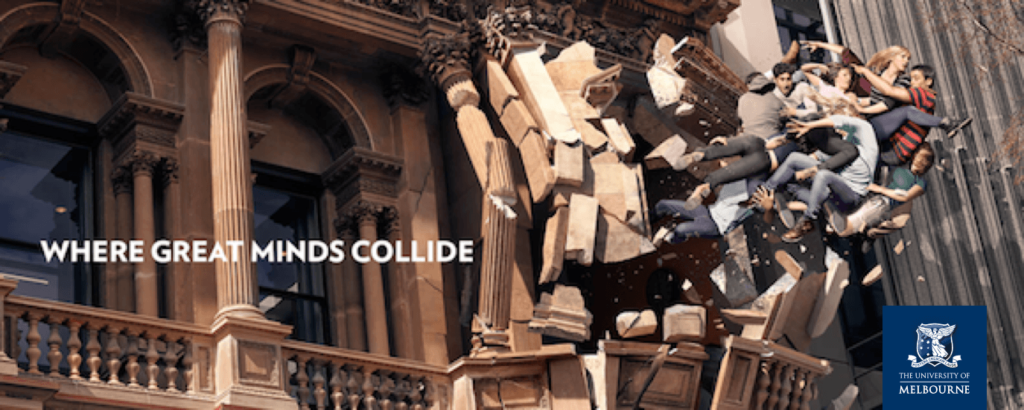Campus Review news editor Patrick Avenell was dismayed to see his local bus displaying an advertisement for his alma mater, Australian National University, the top-ranked university in Australia. He thought the ad, and its placement on a humble people-carrier, cheapened the university's brand. But ANU is not alone in splashing out on flashy marketing, albeit on public transport. In 2015, for instance, the Group of Eight collectively spent $76 million on marketing, advertising and promotions; an average of $9.5 million per university.
But spending doesn't necessarily equate with impact. So, Campus Review asked executives from brand automation and marketing production company Outfit for their thoughts on which university's dollars went the furthest, as well as the dos and don'ts of tertiary promotion.
CR: What makes good university branding?
Ash Thompson: I think one of the really interesting things about uni branding is the fact that a lot of the time they're dealing with heritage. They're also in a space where they're starting to come up against sort of private and quite independent education providers. So I think for university, it's still alluding to their heritage and kind of representing their roots correctly, but also moving with technology, and keeping relevant to prospective students; making sure they don't sort of feel too old.
*****
University of Sydney – "Leadership For Good Starts Here"
Leadership For Good builds on the nostalgia and idealism of university days for some of the university’s esteemed alumni, from former prime minister Gough Whitlam to women’s rights activist and author Anne Summers. Alumni stories and declarations of a vision for good were integrated across outdoor advertising, social media, a short film and the website.
Why we love it: At Outfit, we are sticklers for embracing diversity under unique branding, doing good for the world and building brand equity, and The Monkeys’ campaign delivered on these three qualities in droves. Creative director Paul Bruce put it best via Campaign Brief, saying it, “Uses the equity of the University of Sydney brand to inspire, to instill a renewed sense of pride in being part of the university. It's the first campaign that creates a real emotional connection between past, current and future students delivering a shared vision and purpose for the university community."
*****
What are some pitfalls for universities to look out for in terms of their marketing strategies?
The stuff that tends to go astray is the last minute opportunities that they're trying to take advantage of. Sometimes they don't quite get the right eyes across it or they don't involve the right brand custodians. A good example is when someone will need to put up some signage or run an event at the last minute. When it's created by someone who means well but may not necessarily be a designer, marketing messages can be mixed, and can become diluted.
Why does that sort of inconsistency result in either students being disinterested or in people less likely to want to become students at that institution?
There is an emotional investment that happens to students and prospective students when they're deciding where they're going to study. If you're then stepping on to campus and there's not that brand consistency, it starts to pull away from the brand story. It doesn't take much to call down a lot of hard earned brand equity.
*****
University of Melbourne – "Where Great Minds Collide"
Where Great Minds Collide illustrates mind-blowing moments of interdisciplinary collaboration, from accountants working with botanists to measure the carbon dioxide Melbourne’s botanic garden absorbs, to genomics and cancer treatment researchers teaming up in the fight against melanoma. Creative agency McCann say the challenge was to renew appreciation for the university as more than just a cultural icon: “It’s an institution that facilitates the coming together of the best and brightest thinkers to create real-world discoveries that affect us all".
Why we love it: Where Great Minds Collide stopped us in our tracks with its impactful image of students literally bursting from the university’s buildings. It has stayed with us as an example of a complex concept of the collective power of students executed with creativity and consistency across outdoor advertising, cinematography, social media and the university’s digital content platform Pursuit.
*****
What other components of marketing, apart from branding, can enhance a university's campaign?
Unique photography and tone of voice — how you speak in your marketing — are they friendly or are they a little bit more erudite?
How important are student's voices to the university marketing experience?
Hugely important. A lot of the time, it's the centre of the story. Without the students and without the student achievement, the uni doesn't really have a reason to exist.
*****
Griffith University – "Know More. Do More."
An oldie but a goodie that has stayed in our memories since we saw it on TV, social media and the web in 2011, Know More. Do More. hits on the power of knowledge and what can be done with it. Junior Agency, since acquired by Ogilvy & Mather, later built on the concept to create Know More in 60 Seconds, which they called a “clever and popular way to connect with a massively diverse audience of potential students and staff, while also raising Griffith’s profile".
Why we love it: The simple messaging showcasing the value of knowledge and further consistency of the red couch in Know More. Do More. was a creative anchor for the whole campaign, and tied back to Griffith University’s red logo.
*****
Have you noticed any differences in marketing strategies between different types of universities? So for example, a sandstone versus a red brick or a technical? Or even just location differences; such as regional versus metropolitan?
Not hugely. Not from a brand perspective.
So if the universities tend to communicate in a similar style, how do they differentiate themselves?
Well I think it's a challenge for all of them, and I think they need to continue to understand their point of difference and to leverage that. I think they all do that quite well.
*****
Queensland University of Technology – "A University For The Real World"
This was a refreshingly down-to-earth campaign that simply profiles alumni living in the real world. Via B&T, creative agency BCM says the campaign is all about keeping it real: “From the way the graduates tell their own stories, to the content, the shooting style, and real locations".
Why we love it: Full disclosure: Outfit has a small community of QUT alumni, but this is our very own hall of fame list so we can include what we like. A university for the real world focuses on what most students want from their university, which is just to be a successful graduate. We also love how the campaign builds on consistent branding, messaging and its real-world, real-graduate positioning.
*****
Why do you think universities are moving towards external marketing efforts and how important is this for getting more students on board?
I think there's a lot more competition in the market. Also, going to university is no longer the only option. I think that they need to stay relevant, four years [of a degree] is a really long time, especially with how quickly you can get through job courses now. So I think they really need to find out why a university education going to give people a head start in their chosen field.
What's next for the future of university marketing?
They want to tell their brand story on a more personalised level, so I think we're going to see more around machine learning. Also, they have already started to spend less on traditional [marketing] channels and putting more money into digital marketing, including social media.
*****
Deakin University – "Think Young"
“It’s not about age, it’s about an openness and eagerness to explore the new. Challenging the accepted in search of the exception.” Think Young is an eyeball-sizzlingly bright campaign that demanded our attention. Creative agency The Royals say they drew “inspiration from the Light and Space movement of the 1960s that prefigured today’s merger of art and technology to represent the problems of the future and encourages people to use new thinking to create a better tomorrow".
Why we love it: Breaking with the prestigious shades of navy and trademark reds that define some of the universities included here, this innovative, gutsy campaign stays in our memories for its freshness, newness and colours.
Do you have an idea for a story?
Email [email protected]
 Campus Review The latest in higher education news
Campus Review The latest in higher education news







Can’t see anything wrong with advertising on a bus!
Nor that a bus is too “humble” (and then add in ‘people-carrier’ ?) for university advertising.
Interesting that you didn’t cover Western Sydney University’s rebrand from the University of Western Sydney – easily the most significant University marketing activity in the last 5 years and given the viral video of Deng Adut in their “Unlimited” campaign I would’ve thought you would’ve covered it.
Hi Nathanael. That rebrand was put to Outfit in a question, but their response to same was removed in the editing process. In short, we didn’t forget about WSU!
The mistake in all these campaigns is to focus on the university as a brand and not on the courses or reasons for selecting a university. Reputation carries some weight, but these days decisions are really made at the course level first and then the university second. Also many decisions are made online and via social media (recommendations from peers). The WSU is a worthy exception.
I think the challenge going forward is to promote the diversity of offerings that many universities have and focus on what they do better than the competition. This is possible in more digitally focused campaigns than the old traditional media featured here that young people do not watch or engage with.